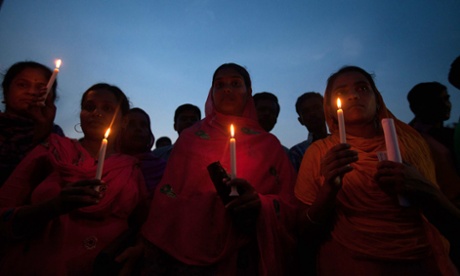
Mamata Khatun worked as a garment quality checker at New Wave Style, a factory on the sixth floor of the Rana Plaza factory in Bangladesh. She worked from 8am until 10pm or even midnight and reports never having had more than two days’ holiday per month. For Eid, Khatun would receive seven days of holiday, but in the preceding weeks the factory would often run all night.
She remembers seeing foreigners visit the factory and being coached about what to say if they were spoken to, which they never were: “A buyer is coming so be alert and be good. If they talk to you just answer like this – you joined at age 18, you get a lunch-break, all is good, all is fine.”
The collapse of Rana Plaza in 2013 killed 1,138 people. It left Khatun disabled with serious injuries to her arms and feet. She went from being the family breadwinner to being dependent on the tiny wage of her husband who works as a vegetable seller.
Two years on, there are 5,000 people like Khatun eligible for compensation for Rana Plaza – but who should pay? In Dhaka, there is anger against factory owners like Bazlus Samad Adnan, who owned New Wave Style, and Sohel Rana who owned Rana Plaza, but there is also anger directed against brands.
New Wave Style produced clothes for dozens of European fashion companies, one of which was Benetton, which recently agreed to pay into a compensation fund after one million people signed a petition calling on it to pay up. Benetton has promised to confirm the amount it would pay before the 24 April anniversary, but why is it expected that an Italian company would pay compensation to workers in Bangladesh that it never directly employed?
Bettina Musiolek from the Clean Clothes Campaign has worked for the rights of garment workers for 20 years. She says: “there was not one single moment or one case that established this relationship of brands paying for people who are not their employees. It was a process over the last 15–20 years of civil society campaigns or human rights campaigns that defined the responsibility of brands and retailers.”
This process led to cases that established an industry precedent of brands taking responsibility for people who are not their direct employees. Two such cases are the 1990s Jessica McClintock case for back wages in the US and the more recent case of German company Adidas paying severance wages to employees at PT Kizone in Indonesia.
While companies who are part of multi-stakeholder initiatives might have accepted this precedent, Jyrki Raina, general secretary of IndustriALL, says: “The fact that the [Rana Plaza] compensation fund is still $8.5m (£5.7m) short shows that very little has changed.”
Biswas Hira is the programme project coordinator at the National Garment Workers Federation in Dhaka and has been working with survivors of the Rana Plaza collapse, some of whom have been abandoned by husbands or in-laws because they can no longer work. She sees it as obvious that fashion brands should pay compensation: “They got money and profit from these factories and these workers. They give orders to Bangladeshi people to make these clothes and give very little salary in return so they can profit more.”
This is a view shared by Jyrki Raina. “Brands were fully aware of the conditions at factories like Rana Plaza but continued business as usual, increasing orders and demanding lower prices. The brands knew that this flawed production model had led to countless accidents and deaths in Bangladesh’s garment factories before the devastating collapse at Rana Plaza.”
But there are others who warn against asking brands for compensation. Ben Powell, director of the Free Market Institute in Texas, sees compensation as part of a total employee compensation package that includes wages and money spent on factory conditions and safety.
He says: “holding companies responsible for compensation claims of their subcontractors in poorer countries raises their expected cost of labour. That causes companies on the margin to substitute away from labour in these poorer countries and use more capital and fewer works and shift employment to richer more productive countries. This forces some workers, who would otherwise work in factories, into less desirable employment alternatives.”
Musiolek describes this threat of flight as “20% true and 80% there to pit workers against each other. In the case of Bangladesh, I haven’t seen any evidence that this is the case.”
“The real power behind the throne is held by the brands,” says Raina. “Brands exercise a huge amount of control on production in the factories, so they have the power to positively influence working conditions and wages as well. If brands do not give compensation and partake in good faith industrial relations then the call for binding international legislation will be stronger.”
The fashion hub is funded by H&M. All content is editorially independent except for pieces labelled ‘brought to you by’. Find out more here.
Join the community of sustainability professionals and experts. Become a GSB member to get more stories like this direct to your inbox.

